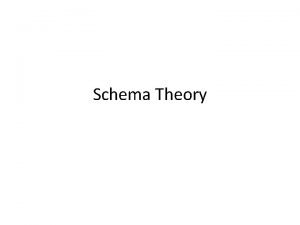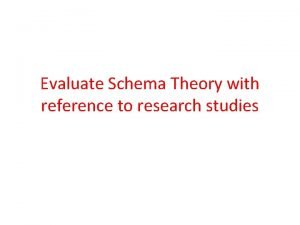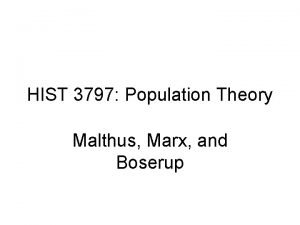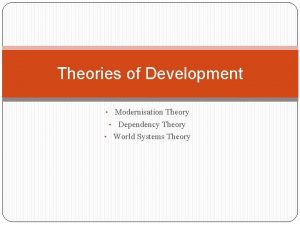POPULATION STUDIES Theories of population Population Theory 1












- Slides: 12

POPULATION STUDIES

Theories of population • Population: Theory # 1. The Malthusian Theory of Population • Population: Theory # 2. The Optimum Theory of Population • Population: Theory # 3. Theory of Demographic Transition

Population: Theory # 1. The Malthusian Theory of Population The Malthusian doctrine is stated as follows: • (1) There is a natural sex instinct in human beings to increase at a fast rate. As a result, population increases in geometrical progression and if unchecked doubles itself every 25 years. Thus starting from 1, population in successive periods of 25 years will be 1, 2, 4, 8, 16, 32, 64, 128, 256 (after 200 years). • (2) On the other hand, the food supply increases in a slow arithmetical progression due to the operation of the law of diminishing returns based on the supposition that the supply of land is constant. Thus the food supply in successive similar periods will be 1, 2, 3, 4, 5, 6, 7, 8, and 9 (after 200 years).

• (3) Since population increases in geometrical progression and the food supply in arithmetical progression, population tends to outrun food supply. Thus an imbalance is created which leads to over-population. This is depicted in Figure 1.

• (4) To control over-population resulting from the imbalance between population and food supply, Malthus suggested preventive checks and positive checks. The preventive checks are applied by a man to control the birth rate. They are foresight, late marriage, celibacy, moral restraint, etc • Malthus doctrine is illustrated below.

• Population: Theory # 2. The Optimum Theory of Population The optimum theory of population was propounded by Edwin Cannan in his book Wealth published in 1924 and popularized by Robbins, Dalton and Carr. Saunders. Unlike the Malthusian theory, the optimum theory does not establish relationship between population growth and food supply. Rather, it is concerned with the relation between the size of population and production of wealth. • The Malthusian theory is a general theory which studies the population problem of a country in keeping with its economic conditions. Thus the optimum theory is more realistic than the Malthusian theory of population.

Definitions: But what is optimum population? The optimum population is the ideal population which combined with the other available resources or means of production of the country will yield the maximum returns or income per head. ASSUMPTIONS: • 1. The natural resources of a country are given at a point of time but they change over time. • 2. There is no change in techniques of production. • 3. The stock of capital remains constant. • 4. The habits and tastes of the people do not change. • 5. The ratio of working population to total population remains constant even with the growth of population. • 6. Working hours of labour do not change. • 7. Modes of business organisation are constant.

THE THEORY • • • Given these assumptions, the optimum population is that ideal size of population which provides the maximum income per head. Any rise or diminution in the size of the population above or below the optimum level will diminish income per head. Given the stock of natural resources, the technique of production and the stock of capital in a country, there is a definite size of population corresponding to the highest per capita income. Other things being equal, any deviation from this optimum-sized population will lead to a reduction in the per capita income. If the increase in population is followed by the increase in per capita income, the country is under-populated and it can afford to increase its population till it reaches the optimum level. On the contrary, if the increase in population leads to diminution in per capita income, the country is over- populated and needs a decline in population till the per capita income is maximised. This is illustrated in Figure 2.

In the figure, OB population is measured along the horizontal axis and per capita income on the vertical axis. In the beginning, there is under-population and per capita income increases with population growth. The per capita income is BA population which is less than the maximum per capita income level NM. The ON size of population represents the optimum level where per capita income NM is the maximum. If there is a continuous increase in population from ON to OD then the law of diminishing returns applies to production. As a result, the per capita production is lowered and the per capita income also declines to DC due to increase in population. Thus ND represents over-population. This is the static version of theory. But the optimum level is not a fixed point.

Population: Theory # 3. Theory of Demographic Transition • The theory of demographic transition is based on the actual population trends of advanced countries of the world. According to this theory, every country passes through three different stages of population growth. In the first stage, the birth rate and the death rate are high and the growth rate of population is low. In the second stage, the birth rate remains stable but the death rate falls rapidly. • As a result, the growth rate of population increases very swiftly. In the last stage, the birth rate starts falling and tends to equal the death rate. The growth rate of population is very slow.

In the figure, the time for different stages is taken on the horizontal axis and annual birth and death rates per thousand on the vertical axis. In the first stage, before the 19 th century, birth rates in Western Europe were 35 per thousand death rates fluctuated around 30 per thousand. Thus the growth rate of population was about 5 per thousand. In the second stage, death rates began to decline gradually from 30 per thousand to 20 per thousand from the middle of the 19 th century to the end of the century. In the third stage beginning with the 20 th century, birth rates began to decline from 20 per thousand have continued for about a century now, nearing 15 per thousand. Death rates also continued to decline but seem to have stabilized between 10 to 55 per thousand in Western Europe.

Conclusion: • The theory of demographic transition is the most acceptable theory of population growth. It neither lays emphasis on food supply like the Malthusian theory, nor does it develop a pessimistic outlook towards population growth. • It is also superior to the optimum theory which lays an exclusive emphasis on the increase in per capita income for the growth of population and neglects the other factors which influence it. The demographic transition theory is superior to all theories of population because it is based on the actual population growth trends of the developed countries of Europe
 Paradigm shift from women studies to gender studies
Paradigm shift from women studies to gender studies What is schema
What is schema Schema memory
Schema memory Evaluate schema theory with reference to research studies
Evaluate schema theory with reference to research studies Early studies led to the development of the cell theory
Early studies led to the development of the cell theory Chapter 4 population ecology test answer key
Chapter 4 population ecology test answer key Section 1 population dynamics
Section 1 population dynamics Population ecology section 1 population dynamics
Population ecology section 1 population dynamics Population ecology section 1 population dynamics answer key
Population ecology section 1 population dynamics answer key Karl marx population theory
Karl marx population theory Trait theory of leadership
Trait theory of leadership The geological theory that states that pieces
The geological theory that states that pieces Modernization theory vs dependency theory
Modernization theory vs dependency theory























